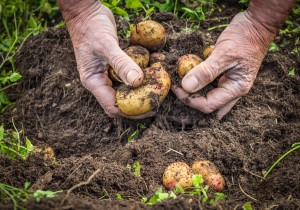This write-up is about “health depends on healthy soil”. I never gave it much thought that soil quality should affect our health until I came across an article to that effect in the June Issue of the BC Medical Journal by Dr. Bill Mackie. It is entitled “Healthy soil, healthy population”. He makes the point that there is only a finite amount of fertile, arable land in British Columbia. The other areas are mountains where no food will grow.
In the past 5 years the Environmental Health Committee of BC (chairman Dr. Bill Mackie) has emphasized the importance of cutting back on the use of antibiotics in managing livestock as it causes resistant strains to enter the food chain and it also changes the bacterial composition of the soil. This damages the environment and it also makes antibiotics less effective in treating most of the bacterial infections.
Soil is a non-renewable resource
Dr. Mackie attended the 4th International Conference on Sustainability Science in France in September 2013. During the conference professor Daniel Nahon asked the question: “Why should we change agriculture?” He stated that apart from global warming that can affect the way crops are cultivated, the techniques of agriculture over the past 100 years have to be reviewed as they contribute to soil erosion, increased resistance of insects to chemicals and more frequent flooding.
Soil creation from continental crust rock to cropable soil takes a long time: to get 4 to 12 inches of bedrock transformed into cropland takes 20,000 to 30,000 years. So, effectively the soils that we encounter in our lifetime are a non-renewable resource.
Soil destruction
This means that we need government agencies to protect arable land. But this is not what is happening: The world’s reserve of cropland is 600 million hectares (=1482 million acres). What is destroying this land? It is soil destruction and soil sterilization. Erosion is the primary reason for soil destruction. This is mostly due to ploughing practices, forest clearing to build subdivisions as part of urbanization and herding associated with raising cattle. All these are responsible for shifting the balance towards soil destruction, which occurs 10 to 100 times faster than soil formation. Erosion rates are 10 tons per hectare (or 4 tons per acre) over 80% of Earth’s arable land.
With regard to urbanization keep in mind that in 1900 only 14% of the world population lived in cities. However, in 2000, 54% of the world population consisted of urban dwellers.
Soil erosion
Some more data: In the US 100 square meters (1076.3 square feet) are lost every second. China is losing 500 square meters (5381.5 square feet) every second. When you translate that into an easy to imagine figure, these two countries alone destroy the area of Denmark each year!
Dr. Mackie stated that when current trends of global food production are stacked against global population increases, we will reach a point in 3 centuries from now where the population will no longer be able to grow enough food to feed itself.
Preserving agricultural land
There are many unknowns though: This projection could be reached earlier, if there is more soil erosion than anticipated, but it could also be delayed by conservation practices. In British Columbia there has been a Provincial Land Commission since 2002 that developed strict agricultural zoning laws, called Agricultural Land Reserve (ALR). This makes it difficult for developers to build on valuable agricultural land, no matter how desirable this land would be from a real estate point of view. In BC this law has been instrumental in preserving agricultural land on the erosion side of the equation as mentioned above.
Health concerns
There are health concerns because of monoculture techniques that are employed on a large scale. With the monoculture practice artificial fertilizers have to be used to replenish the soil. But the plants are hardly extracting 50% of the fertilizers from the soil; the rest becomes part of agro pollution. Nitrogen and phosphorus are the main pollutants. A few years back some children consumed nitrate-contaminated water. Doctors diagnosed them as “blue baby syndrome”. Methemoglobinemia caused this condition. I could lead to brain damage or death. Now babies are fed formulas with water from reverse osmosis or bottled water. The Center for Disease Control also linked miscarriages to high nitrate levels in drinking water.
Over-fertilization
Another effect of over-fertilization is the leaching out of important minerals like calcium, magnesium and potassium. These minerals are then low in vegetables we eat and this affects our metabolism, as magnesium for instance is a co-factor in hundreds of enzymatic reactions in the body.
Concentrated animal feeding operations cause problems with regard to manure disposal. The farmers of these animals use heavy metals to promote growth and this results in high concentrations of arsenic, copper, selenium and zinc in the manure. This leaches into ground water and kills wildlife. But there are also antibiotic residues and resistant bugs in the manure of these concentrated animal feeding operations. In addition the animals carry superbugs, which can cause serious problems in humans.
Toxicity of food
With the monoculture techniques minerals and nutrients leached out of the soil and farmers used fertilizers, insecticides and Roundup weed killer to maintain the monocultures. This was good business for the chemical companies that produced all those substances, but has not been good for our health despite reassurances otherwise. The end result is that we humans have to deal with residues of insecticides in our food that function as estrogen-like substances causing cancer on the long-term.
Effects of Roundup and GMO crops
We also get exposed to Roundup that has been classified by the World Health Organization as “probably carcinogenic in humans” (category 2A carcinogenic).
Fertilizers are rich in heavy metals and have been found to cause cancer and methemoglobinemia.
Add to this the GMO issue that has not been resolved. Large manufacturers and those who are heavily invested in them are again pushing the envelope to the limit, but GMO crops are not harmless as some reports of infertility, breast cancer, malformations in newborns and autoimmune reactions in humans have shown.
GMO and “standard farming practices”
Scientists did not analyze GMO for GMO for toxic effects. Researchers tested GMO products on animals over a 3 month period. This will not do regarding safety in humans. It is sad that the GMO scientists in the US forced the population involuntarily in a long-term toxicity study. Since the industry declared GMO in the US as “safe”, GMO food is now widely available in stores. In Europe governments were more cautious and did not allow GMO as freely. I prefer organic food, which is a certain protection from insecticides, fertilizers, Roundup and GMO.
The “standard farming practices” have insidious effects on our health and need to be reviewed by medical experts. One of the problems of starting new agroindustry practices was the fact that there was no input from consumers, from health professionals or scientists to look at how this would affect us as humans. The old-fashioned way of just doing something and waiting until there is a crisis does not work anymore in society today.
Discussion
Conservation agriculture employs three key principles that are worth mentioning:
1. Practice minimum mechanical soil disturbance, which is essential to maintaining minerals within the soil, stopping erosion, and preventing water loss.
2. Manage the topsoil to create a permanent organic soil cover; this allows for growth of organisms within the soil structure.
3. Adopt the practice of crop rotation with more than two species. This controls weeds and insects and cuts down the need for chemical sprays.
Recycling garden refuse is a good way to create natural fertilizer. The city of Kelowna, BC has developed the manufacturing of OgoGrow, which they call a “soil amendment”.
This is a mineral and organic compound rich soil that can be mixed with existing poor soil thus turning it into a higher quality soil.
Conclusion
With proper planning worldwide, programs like these work. Some form of agricultural land reserve legislation combined with soil enrichment with products similar to OgoGrow will slow down soil erosion.
Tampering with the food production of future generations is not an allowable option. We need more international conferences on sustainability science as mentioned above. But we also need activists in all countries looking out for our food quality.
At the present time the only alternative to eating tampered food is to buy organic food. Don’t allow chemical companies to mess with the quality of soil bacteria or food quality, don’t allow farmers to mess with antibiotics that contaminates your meat with superbugs. It is a multifaceted task that will involve worldwide co-operation.
Mankind depends on this kind of work to survive!
Reference
“Healthy soil, healthy population” by Bill Mackie, MD Chairman of Environmental Health Committee, BC/Canada BC Medical Journal Vol. 57, No.5, June 2015, page 201.







